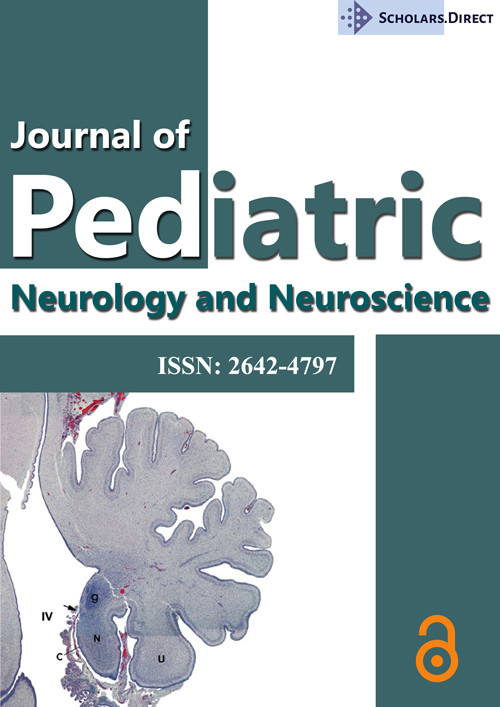Ketamine Therapy in the Management of Refractory Seizures in an Extremely Premature Neonate: A Case Report
Abstract
Background: Neonatal seizures, particularly refractory status epilepticus (RSE), pose significant challenges in neonatal intensive care units (NICUs), especially in extremely premature infants. These patients are at increased risk due to brain immaturity and heightened susceptibility to complications. While conventional treatments often fail, ketamine, a noncompetitive N-methyl-D-aspartate (NMDA) receptor antagonist, has shown promise as adjunctive therapy for RSE in pediatric and adult populations.
Patient: We present a case of an extremely premature infant, born at 25 weeks gestational age, who developed refractory status epilepticus complicated by multiple comorbidities, including germinal matrix hemorrhages, bacterial infection, and hyaline membrane disease. Despite treatment with Phenobarbital, Keppra, Fosphenytoin, and Midazolam, the patient’s seizures remained uncontrolled until a ketamine infusion was initiated.
Results: Ketamine infusion significantly suppressed seizure activity without side effects or hemodynamic changes, allowing for the successful discontinuation of ketamine without seizure recurrence. The patient was gradually weaned off all antiseizure medications and remained seizure-free at the time of manuscript preparation.
Conclusion: This case demonstrates the potential role of ketamine as an adjunctive therapy in managing refractory status epilepticus in extremely premature neonates. Given its effectiveness in this case, further research is needed to establish optimal dosing, safety, and long-term outcomes of ketamine in this vulnerable patient population.
Background
Neonatal seizures are a common neurological emergency in NICUs, often requiring aggressive treatment to prevent long-term neurodevelopmental sequelae [1]. Refractory status epilepticus (RSE) in extremely premature infants adds further complexity to management due to underlying brain immaturity and susceptibility to complications. Ketamine, a noncompetitive N-methyl-D-aspartate (NMDA) receptor antagonist, has emerged as a potential adjunctive therapy for RSE in pediatric and adult populations [2]. Its unique mechanism of action, distinct from conventional antiepileptic drugs, offers promise in cases of pharmaco-resistant seizures, as suggested by its recent increased use [3]. Though a few case reports describe its use in neonates, there is limited evidence regarding the efficacy and safety of ketamine in extremely premature neonates, necessitating further investigation [4,5].
This case report aims to contribute to the existing literature by presenting a detailed account of the use of ketamine in the management of RSE in a baby born at 25 weeks gestational age, highlighting its potential as a therapeutic option in this challenging clinical scenario.
Description of the Case
On the third day of life, a head ultrasound (HUS) revealed a grade four germinal matrix hemorrhage on the left side and a grade one on the right side. By day eleven, concerns for sepsis led to a blood culture confirming Escherichia coli ( E. coli ) infection, and cerebrospinal fluid (CSF) findings suggested meningitis, prompting treatment with meningitic doses of antibiotics. A repeat HUS on day thirteen showed the progression of the hemorrhages with increased debris and septations in the ventricular system. During this time, the patient experienced frequent events concerning seizures described as oxygen desaturation with bradycardia and upper limb stiffening. Neurology consultation led to video EEG monitoring, which identified multiple seizures with myoclonic, tonic, and clonic elements, some lasting up to five minutes. Initial phenobarbital treatment provided temporary relief, but seizures recurred, necessitating maintenance therapy. Figure 1 illustrates a diagram of the patient's hospital course, with Day 0 marking the onset of observed seizure-like activity.
Over subsequent days, the patient’s seizures became more frequent. Phenobarbital loading doses, followed by Levetiracetam and Lorazepam, provided only transient or minimal benefits, with seizures persisting in both electrographic and electroclinical forms. A Fosphenytoin load also failed to impact seizure activity significantly. Despite escalating interventions, including multiple medications and dosing adjustments, the patient continued to exhibit recurrent bilateral seizures involving both upper and lower extremities. Midazolam drip was started but resulted in worsening of the seizures (Figure 2 shows a right central and midline seizure after Midazolam). Given the refractory nature of her seizures, ketamine was introduced as a last-line treatment, marking a further escalation in the management strategy. This was discussed with the on-service neonatologist and the patient’s mother, as this was not a conventional medication used to treat premature neonatal seizures.
The patient was administered Ketamine in small boluses of 1 mg/kg, and following three well-tolerated boluses, an infusion was initiated at 10 mcg/kg/min and gradually titrated up to 70 mcg/kg/min. This intervention led to a marked reduction in seizures, though sporadically, some electrographic seizures originating from the right and left central and parasagittal regions were noted. Over the subsequent two days, sporadic seizures persisted, occasionally lasting up to two minutes. After three days of Ketamine infusion with satisfactory seizure control, we initiated a weaning protocol by reducing the infusion rate by 10 mcg/kg/min every four hours. However, seizure activity returned when the infusion was tapered to 30 mcg/kg/min. The infusion was subsequently increased to 50 mcg/kg/min, and a Fosphenytoin loading dose was administered, which resulted in a favorable response. Scheduled Fosphenytoin dosing was then implemented, and the Ketamine infusion was maintained.
Two days later, we resumed a slower weaning process while continuing maintenance therapy with Fosphenytoin, phenobarbital, and Levetiracetam. The Ketamine infusion was successfully discontinued after a total of seven days of treatment, coinciding with day 12 since the onset of seizures. The following day, a single subclinical seizure was detected on EEG in the left central/temporal areas, prompting a Fosphenytoin loading dose. The next day, the patient experienced recurrent subclinical seizures originating from the right temporal region at a frequency of approximately two per hour, each lasting under one minute and characterized by 1 Hz multiphasic sharp/slow complexes with downward frequency evolution. A partial Fosphenytoin load was administered, leading to the cessation of seizure activity for over 48 hours.
The rest of her NICU stay was notable for the resolution of the sepsis and meningitis with negative blood and CSF cultures after bilateral endoscopic ventricular lavage, bilateral endoscopic cyst fenestrations, and six weeks of anti-biotherapy. She had developed posthemorrhagic hydrocephalus for which an Omaya reservoir was initially placed, followed by externalized ventricular drains, and later transitioned to bilateral ventriculoperitoneal shunts. She was extubated and slowly weaned to room air; she could tolerate her feedings orally. She went home from the neonatal intensive care unit at 45 weeks and two days corrected gestational age on Levetiracetam only.
At the time of the writing of this manuscript, her mother had weaned her off Levetiracetam, and she had remained seizure-free; however, her most recent EEG showed some left parasagittal epileptiform discharges (Figure 3), and we have been obtaining frequent EEG studies to monitor for epileptic spasms.
Discussion
Ketamine, an NMDA receptor antagonist, has emerged as a potential therapeutic agent for refractory status epilepticus (RSE) when traditional antiepileptic drugs fail. The pharmacological profile of ketamine allows it to inhibit excitotoxicity mediated by NMDA receptors, providing a unique mechanism of action distinct from other anticonvulsants [2,6]. In our case, ketamine administration resulted in a significant reduction in seizure frequency and duration, highlighting its effectiveness in controlling RSE in neonates. Several studies have supported ketamine’s utility in managing RSE across different age groups, though its application in neonates, particularly preterm infants, is yet to be determined [7-9].
Its use in term neonates has been described in the literature; Pin, et al. and Tarocco, et al. described neonates with RSE refractory to multiple AEDs, including phenobarbital, levetiracetam, phenytoin, and midazolam [10,11]. Initiation of ketamine infusion resulted in successful seizure control, allowing for the discontinuation of other AEDs and sedative drugs. These findings highlight ketamine's potential as an effective adjunctive therapy for neonatal RSE, providing a novel treatment option when conventional therapies fail. However, in most reports, Ketamine is typically administered later in the course - a study of 48 children with refractory status epilepticus (RSE) treated with ketamine found that all patients also received pentobarbital. This timing and combination limit the applicability of the results, particularly for initial treatment strategies [3].
In children, the IV anesthetic agents commonly used to treat RSE are midazolam and barbiturates [12]. Comparing Ketamine to other antiepileptic medications, Jacobwitz, et al. conducted a retrospective study comparing the efficacy of ketamine and midazolam as first-line anesthetic infusions for refractory status epilepticus in neonates. The study found that seizures were terminated more often in patients administered ketamine compared to midazolam. Furthermore, a more significant proportion of patients administered ketamine had successful seizure termination compared to those receiving midazolam. These results suggest that ketamine may offer superior efficacy in terminating seizures compared to midazolam, supporting its consideration as a first-line therapy for neonatal RSE [13,14].
Determining the appropriate dosing of ketamine for neonatal seizures is critical. In the presented case, ketamine was administered in small boluses of 1 mg/kg, followed by an infusion starting at 10 mcg/kg/min and gradually increased to 70 mcg/kg/min. This dosing regimen was also applied by Pin, et al. in the case of a neonate born at 40 weeks gestational age and with refractory seizures, it was titrated up to 100 mcg/kg/min to effectively control seizures while minimizing potential side effects [10]. Reviewing the literature of 214 articles, Pin, et al. noted that Ketamine dosage ranged from 1.5 mcg/kg/h up to 100 mcg/kg/h and was administered for a total of 8-28 days; this is similar to our patient, who necessitated the Ketamine infusion for about seven days to achieve reasonable seizures control [10]. The wide variability in ketamine dosing reflects the lack of established guidelines or recommendations on the appropriate dose for its use.
Despite its benefits, ketamine use is associated with several side effects. In neonates, potential adverse effects include cardiovascular instability, increased intracranial pressure, and neurotoxicity - One possible mechanism being neuronal apoptosis by the blockade of NMDA receptors [15]. In our case, ketamine was well tolerated acutely - which is similar to what was described by Kuki, et al. [16]. Ketamine has shown neuroprotective effects in animal models, as demonstrated by Fujikawa, who found that it significantly reduced seizure discharge amplitudes and provided neuroprotection in 22 of 24 brain regions, with EEG seizure activity ceasing in three cases within 30 minutes without neuronal damage observed in those cases [17]. However, the long-term effects of ketamine use in preterm infants are not well understood. Ketamine can be neuroprotective and help control intractable seizures, but the concern for long-term neurodevelopmental outcomes remains. There is evidence suggesting that ketamine can induce neuronal apoptosis in the developing brain, raising concerns about its safety profile in this vulnerable population [18]. Rosati, et al. also report brain atrophic changes were seen in 4 of the six patients of their series after KE treatment but were likely ascribable to the underlying pathology [8]. However, the immediate need to control life-threatening seizures often outweighs these risks. Our patient’s ongoing development will need careful evaluation to identify any long-term adverse outcomes related to ketamine use.
Conclusion
In conclusion, ketamine holds promise as an adjunctive therapy for neonatal RSE refractory to conventional AEDs. The reported cases and comparative studies provide valuable insights into ketamine's efficacy and safety profile in managing neonatal RSE, highlighting its potential as a therapeutic option in this challenging clinical scenario. However, further research is needed to address remaining uncertainties and optimize treatment strategies, ultimately improving outcomes for neonates affected by RSE.
References
- Pressler RM, Abend NS, Auvin S, et al. (2023) Treatment of seizures in the neonate: Guidelines and consensus-based recommendations - Special report from the ILAE Task Force on Neonatal Seizures. Epilepsia 64: 2550-2570.
- Sinner B, Graf BM (2008) Ketamine. Handb Exp Pharmacol 2008: 313-333.
- Keros S, Buraniqi E, Alex B, et al. (2017) Increasing ketamine use for refractory status epilepticus in US pediatric hospitals. J Child Neurol 32: 638-646.
- Huntsman RJ, Strueby L, Bingham W (2020) Are ketamine infusions a viable therapeutic option for refractory neonatal seizures? Pediatr Neurol 103: 8-11.
- Samanta D (2020) Ketamine in Refractory Neonatal Seizures. Pediatr Neurol 106: 76.
- Dingledine R, Borges K, Bowie D, et al. (1999) The glutamate receptor ion channels. Pharmacol Rev 51: 7-61.
- Rosati A, De Masi S, Guerrini R (2018) Ketamine for refractory status epilepticus: A systematic review. CNS Drugs 32: 997-1009.
- Rosati A, L’Erario M, Ilvento L, et al. (2012) Efficacy and safety of ketamine in refractory status epilepticus in children. Neurology 79: 2355-2358.
- Wu J, Wang Q, Qian SY, et al. (2020) [Effectiveness of ketamine in the treatment of refractory and super-refractory status epilepticus in children]. Zhonghua Er Ke Za Zhi Chin J Pediatr 58: 295-300.
- Pin JN, Leonardi L, Nosadini M, et al. (2023) Efficacy and safety of ketamine for neonatal refractory status epilepticus: case report and systematic review. Front Pediatr 11: 1189478.
- Synowiec AS, Singh DS, Yenugadhati V, et al. (2013) Ketamine use in the treatment of refractory status epilepticus. Epilepsy Res 105: 183-188.
- Abend NS, Dlugos DJ (2008) Treatment of refractory status epilepticus: Literature review and a proposed protocol. Pediatr Neurol 38: 377-390.
- Jacobwitz M, Mulvihill C, Kaufman MC, et al. (2022) Ketamine for management of neonatal and pediatric refractory status epilepticus. Neurology 99: e1227-e1238.
- Gaspard N, Foreman B, Judd LM, et al. (2013) Intravenous ketamine for the treatment of refractory status epilepticus: A retrospective multi-center study. Epilepsia 54: 1498-1503.
- Rosenbaum SB, Gupta V, Patel P, et al. (2024) Ketamine. In: StatPearls [Internet]. Treasure Island (FL): StatPearls Publishing.
- Kuki I, Inoue T, Fukuoka M, et al. (2024) Efficacy and safety of ketamine for pediatric and adolescent super-refractory status epilepticus and the effect of cerebral inflammatory conditions. J Neurol Sci 459: 122950.
- Fujikawa DG (1995) Neuroprotective effect of ketamine administered after status epilepticus onset. Epilepsia 36: 186-195.
- Bittigau P, Sifringer M, Ikonomidou C (2003) Antiepileptic drugs and apoptosis in the developing brain. Ann N Y Acad Sci 993: 103-114.
Corresponding Author
Vanessa Mbanga, MD, Department of Pediatric Neurology, Saint Louis University School of Medicine, 1465 S. Grand Blvd, St. Louis, MO, 63104, USA.
Copyright
© 2024 Mbanga V, et al. This is an open-access article distributed under the terms of the Creative Commons Attribution License, which permits unrestricted use, distribution, and reproduction in any medium, provided the original author and source are credited.







